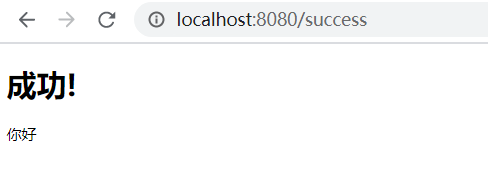3.自己编写业务代码
自动配置原理?
这个场景SpringBoot 帮我们配置了什么? 能不能修改?能修改哪些配置?能不能扩展?xxx
xxxAutoConfiguration:帮我们给容器中自动配置组件
xxxProperties: 配置类来封装配置文件的内容
一.创建简单的WEB应用





测试Hello word

运行场景启动器

成功访问
二. SpringBoot 对静态资源的映射规则
@ConfigurationProperties(prefix = "spring.resources", ignoreUnknownFields = false)
public class ResourceProperties implements ResourceLoaderAware {
//可以设置和静态资源有关的参数,缓存时间等
WebMvcAuotConfiguration:
@Override
public void addResourceHandlers(ResourceHandlerRegistry registry) {
if (!this.resourceProperties.isAddMappings()) {
logger.debug("Default resource handling disabled");
return;
}
Integer cachePeriod = this.resourceProperties.getCachePeriod();
if (!registry.hasMappingForPattern("/webjars/**")) {
customizeResourceHandlerRegistration(
registry.addResourceHandler("/webjars/**")
.addResourceLocations(
"classpath:/META-INF/resources/webjars/")
.setCachePeriod(cachePeriod));
}
String staticPathPattern = this.mvcProperties.getStaticPathPattern();
//静态资源文件夹映射
if (!registry.hasMappingForPattern(staticPathPattern)) {
customizeResourceHandlerRegistration(
registry.addResourceHandler(staticPathPattern)
.addResourceLocations(
this.resourceProperties.getStaticLocations())
.setCachePeriod(cachePeriod));
}
}
//配置欢迎页映射
@Bean
public WelcomePageHandlerMapping welcomePageHandlerMapping(
ResourceProperties resourceProperties) {
return new WelcomePageHandlerMapping(resourceProperties.getWelcomePage(),
this.mvcProperties.getStaticPathPattern());
}
//配置喜欢的图标
@Configuration
@ConditionalOnProperty(value = "spring.mvc.favicon.enabled", matchIfMissing = true)
public static class FaviconConfiguration {
private final ResourceProperties resourceProperties;
public FaviconConfiguration(ResourceProperties resourceProperties) {
this.resourceProperties = resourceProperties;
}
@Bean
public SimpleUrlHandlerMapping faviconHandlerMapping() {
SimpleUrlHandlerMapping mapping = new SimpleUrlHandlerMapping();
mapping.setOrder(Ordered.HIGHEST_PRECEDENCE + 1);
//所有 **/favicon.ico
mapping.setUrlMap(Collections.singletonMap("**/favicon.ico",
faviconRequestHandler()));
return mapping;
}
@Bean
public ResourceHttpRequestHandler faviconRequestHandler() {
ResourceHttpRequestHandler requestHandler = new ResourceHttpRequestHandler();
requestHandler
.setLocations(this.resourceProperties.getFaviconLocations());
return requestHandler;
}
}
1).所有/webjars/**,都去classpath:/META-INF/resources/webjars/找资源;
webjars: 以jar包的形式引入静态资源;
www.webjars.org


在访问的时候只需要写webjars 下面的资源名称即可
localhost:8080/webjars/jquery/3.3.1/jquery.js
2). /** 访问当前项目的任何资源(静态资源的文件夹)
"classpath:/META-INF/resources/",
"classpath:/resources/",
"classpath:/static/",
"classpath:/public/"
"/":当前项目的根路径
localhost:8080/abc === 去静态资源文件夹里面找abc
3)、欢迎页; 静态资源文件夹下的所有index.html页面;被"/**"映射;

localhost:8080/ 找index页面

4)、所有的 **/favicon.ico 都是在静态资源文件下找;


自己定义一个映射资源访问路径: 在application.propertis文件中加入
spring.resources.static-locations=classpath:/hello/,classpath:/xuexi/
三. 模板引擎
JSP、Velocity、Freemarker、Thymeleaf
SpringBoot 推荐使用 Thymeleaf 语法简单,功能更强大
1.引入 Thymeleaf
<dependency>
<groupId>org.springframework.boot</groupId>
<artifactId>spring-boot-starter-thymeleaf</artifactId>
</dependency>
Thymeleaf 的语法
@ConfigurationProperties(prefix = "spring.thymeleaf")
public class ThymeleafProperties {
private static final Charset DEFAULT_ENCODING = Charset.forName("UTF-8");
private static final MimeType DEFAULT_CONTENT_TYPE = MimeType.valueOf("text/html");
public static final String DEFAULT_PREFIX = "classpath:/templates/";
public static final String DEFAULT_SUFFIX = ".html";
//
只要我们把HTML页面放在classpath:/templates/,thymeleaf就能自动渲染;



Thymeleaf 的使用
使用:
1.导入Thymeleaf 的名称空间
<html lang="en" xmlns:th="http://www.thymeleaf.org">
2.使用Thymeleaf 的语法

<!DOCTYPE html>
<html lang="en" xmlns:th="http://www.thymeleaf.org" >
<head>
<meta charset="UTF-8">
<title>Title</title>
</head>
<body>
<h1>成功!</h1>
<div th:text="${hello}">如果返回值里没有信息,它会显示这里的默认信息</div>
</body>
</html>

3.语法规则
1).th:text; 改变当前元素里面的文本内容;
th: 任意html属性;来替换原生属性的值;
<div id = "div01" class = "divClass" th:id="${hello}" th:class="${hello}" th:text="${hello}">如果返回值里没有信息,它会显示这里的默认信息</div>


2).表达式语法
Simple expressions:(表达式语法)
Variable Expressions: ${...}:获取变量值;OGNL;
1)、获取对象的属性、调用方法
2)、使用内置的基本对象:
#ctx : the context object.
#vars: the context variables.
#locale : the context locale.
#request : (only in Web Contexts) the HttpServletRequest object.
#response : (only in Web Contexts) the HttpServletResponse object.
#session : (only in Web Contexts) the HttpSession object.
#servletContext : (only in Web Contexts) the ServletContext object.
${session.foo}
3)、内置的一些工具对象:
#execInfo : information about the template being processed.
#messages : methods for obtaining externalized messages inside variables expressions, in the same way as they would be obtained using #{…} syntax.
#uris : methods for escaping parts of URLs/URIs
#conversions : methods for executing the configured conversion service (if any).
#dates : methods for java.util.Date objects: formatting, component extraction, etc.
#calendars : analogous to #dates , but for java.util.Calendar objects.
#numbers : methods for formatting numeric objects.
#strings : methods for String objects: contains, startsWith, prepending/appending, etc.
#objects : methods for objects in general.
#bools : methods for boolean evaluation.
#arrays : methods for arrays.
#lists : methods for lists.
#sets : methods for sets.
#maps : methods for maps.
#aggregates : methods for creating aggregates on arrays or collections.
#ids : methods for dealing with id attributes that might be repeated (for example, as a result of an iteration).
Selection Variable Expressions: *{...}:选择表达式:和${}在功能上是一样;
补充:配合 th:object="${session.user}:
<div th:object="${session.user}">
<p>Name: <span th:text="*{firstName}">Sebastian</span>.</p>
<p>Surname: <span th:text="*{lastName}">Pepper</span>.</p>
<p>Nationality: <span th:text="*{nationality}">Saturn</span>.</p>
</div>
Message Expressions: #{...}:获取国际化内容
Link URL Expressions: @{...}:定义URL;
@{/order/process(execId=${execId},execType='FAST')}
Fragment Expressions: ~{...}:片段引用表达式
<div th:insert="~{commons :: main}">...</div>
Literals(字面量)
Text literals: 'one text' , 'Another one!' ,…
Number literals: 0 , 34 , 3.0 , 12.3 ,…
Boolean literals: true , false
Null literal: null
Literal tokens: one , sometext , main ,…
Text operations:(文本操作)
String concatenation: +
Literal substitutions: |The name is ${name}|
Arithmetic operations:(数学运算)
Binary operators: + , - , * , / , %
Minus sign (unary operator): -
Boolean operations:(布尔运算)
Binary operators: and , or
Boolean negation (unary operator): ! , not
Comparisons and equality:(比较运算)
Comparators: > , < , >= , <= ( gt , lt , ge , le )
Equality operators: == , != ( eq , ne )
Conditional operators:条件运算(三元运算符)
If-then: (if) ? (then)
If-then-else: (if) ? (then) : (else)
Default: (value) ?: (defaultvalue)
Special tokens:
No-Operation: _
测试
@RequestMapping("/success")
public String success(Map<String,Object> map){
map.put("hello","你好");
map.put("users", Arrays.asList("张三","李四","王五"));
map.put("utext","<h1>测试utext</h1>");
map.put("text","<h1>测试utext</h1>");
return "success";
}
<hr/>
<div th:text = "${text}"></div>
<div th:utext = "${utext}"></div>
<hr/>
<!-- th:each 每次遍历都会生成当前这个标签,3个h4-->
<h4 th:text="${user}" th:each="user:${users}"></h4>
<h4>
<!--[[ ...]] 语法:相当于 th:text [(...)]语法 相当于 th:utext-->
<span th:each="user:${users}">[[${user}]]</span>
</h4>

引入自己的静态资源的方式 th:href="@{asserts/css/signin.css}",如果引入的是jar包里的静态资源
<link href="asserts/css/signin.css" th:href="@{asserts/css/signin.css}" rel="stylesheet">
<link href="asserts/css/bootstrap.min.css" th:href="@{/webjars/bootstrap/4.4.1-1/css/bootstrap.css}" rel="stylesheet">

th:action="@{/user/login}"
<form class="form-signin" th:action="@{/user/login}" methed = "post">
th:if="${ not #strings.isEmpty(msg)}" //引入strings对象判断值是否存在,不存在不创建p标签
<p style="color:red;" th:text="${msg}" th:if="${ not #strings.isEmpty(msg)}"></p>
[[${session.loginUser}]] :从session中获取信息






















 2101
2101











 被折叠的 条评论
为什么被折叠?
被折叠的 条评论
为什么被折叠?








